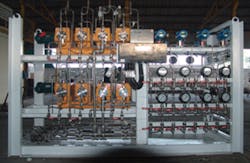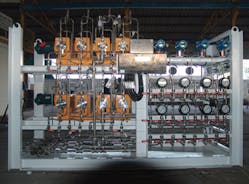While the surge in oil and gas exploration has been a boon for a number of flowmeter types, including ultrasonic and turbine, positive-displacement (PD) flowmeters have benefited more from the downstream end of the business. Oval gear meters, for example, are incorporated into skids for use in downstream custody transfer of petroleum liquids, and PD meters are also widely used in trucking terminals for loading and offloading hydrocarbons.
PD flowmeters have long been favored for gas applications. Many of the PD meters used for gas utility measurements are diaphragm meters. However, diaphragm meters are being replaced in some applications by smaller and lighter rotary meters, which are also used for non-utility gas flow measurement in industrial environments where they figure to benefit from the rise in natural gas use.
PD flowmeters are also popular for downstream distribution of refined petroleum liquids. With the price of oil in the range of $100 per barrel, the value of petroleum measurement has escalated. The high prices put a premium on accuracy and reliability in measurement, and PD flowmeters rank high on both counts. While they do face competition from Coriolis flowmeters for downstream petroleum applications, especially for custody transfer, the high price of Coriolis meters is causing many customers to stay with PD meters. Oval gear meters are especially popular for these applications.
READ ALSO:
- Energy and Large-Pipe Applications Drive Coriolis Technology to New Heights
- Differential Pressure Maintains a Powerful Place in the World of Flow Measurement
- Magmeters Top the Flowmeter Market In Revenue
- Emissions Monitoring Applications Propel Thermal Flowmeter Market
- Turbine Flowmeters Remain Competitive in Turbulent Market
- Custody-Transfer Applications Drive Ultrasonic Flowmeter Growth
- Vortex Flowmeters Prove Their Worth In Steam Flow Measurement
With a lot of revenue at stake in oil & gas applications, PD meter suppliers are taking steps to improve their technology. Some relatively new developments focus on improved methods to increase the precision with which components are manufactured. For example, improved coordinate measuring machines make it possible to create more perfectly round pistons and other components. And as is the case with turbine flowmeters, improved bearing technology is making PD meters more reliable and less prone to failure.
Another major growth factor for PD flowmeters is the large installed base of positive displacement flowmeters worldwide. Because PD meters were introduced in the 1840s—more than 100 years before new-technology meters—they’ve had much more time to penetrate the markets in Europe, North America, and Asia. Installed base is a relevant growth factor because often when ordering flowmeters, especially for replacement purposes, users choose to stay with the same technology rather than invest the time and money to train people how to install and use a new flowmeter type.
To read more about Flow Research’s work in the area of PD flow measurement, visit www.flowPD.com.



